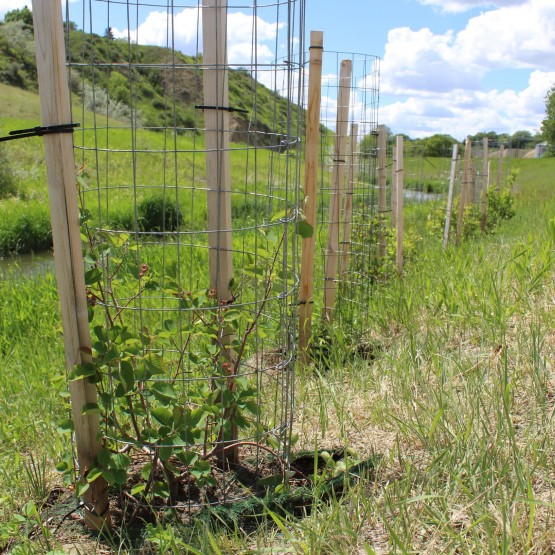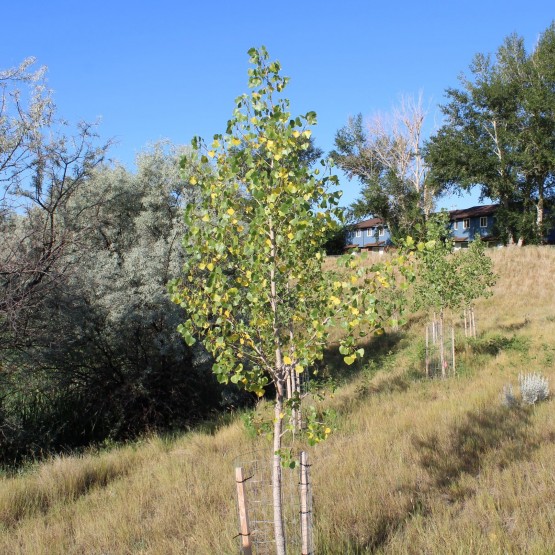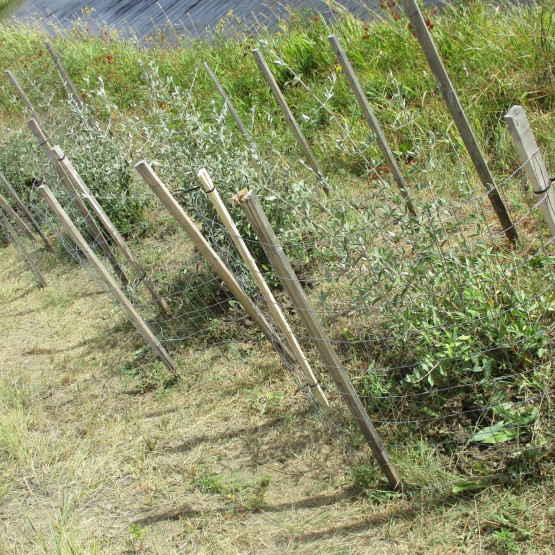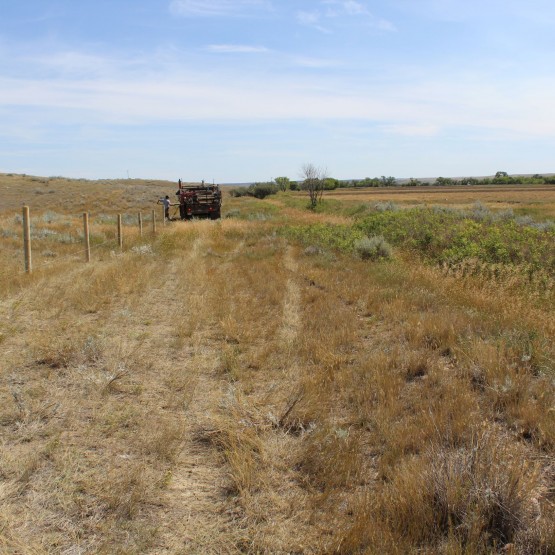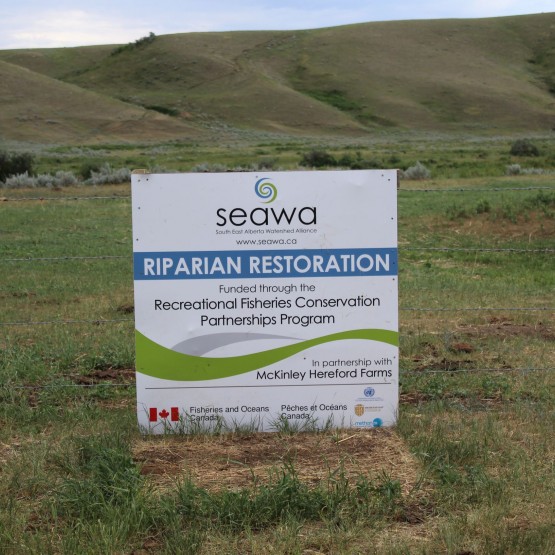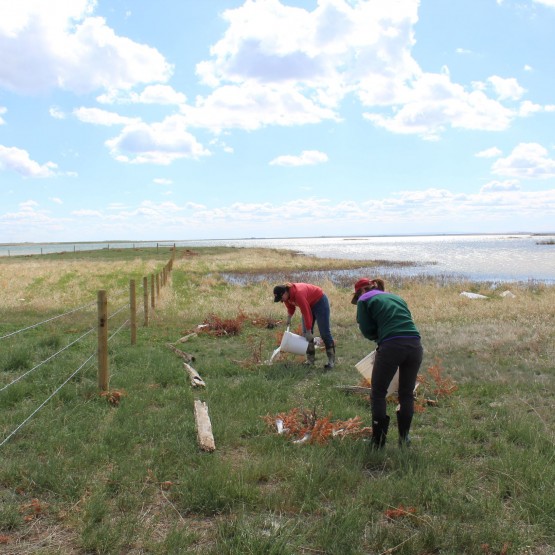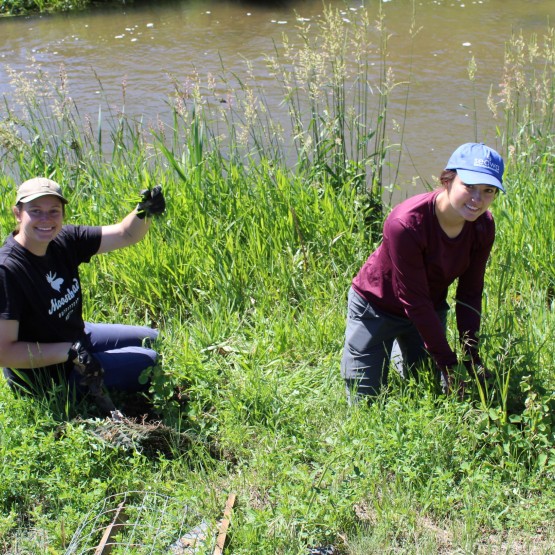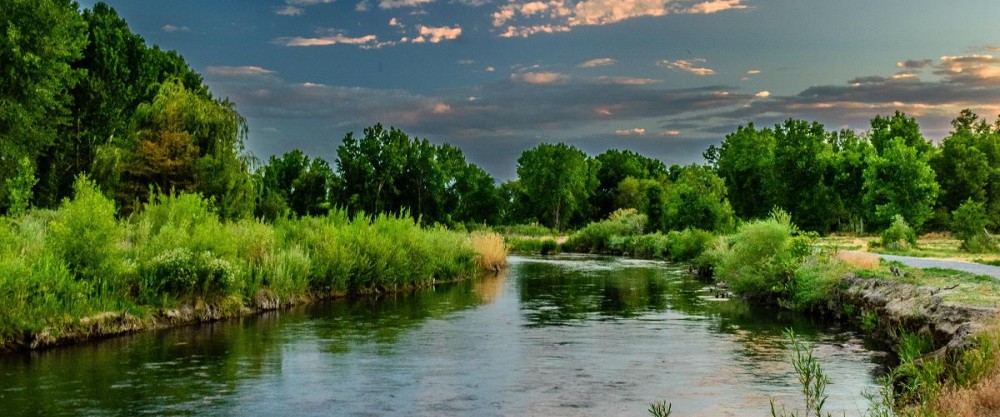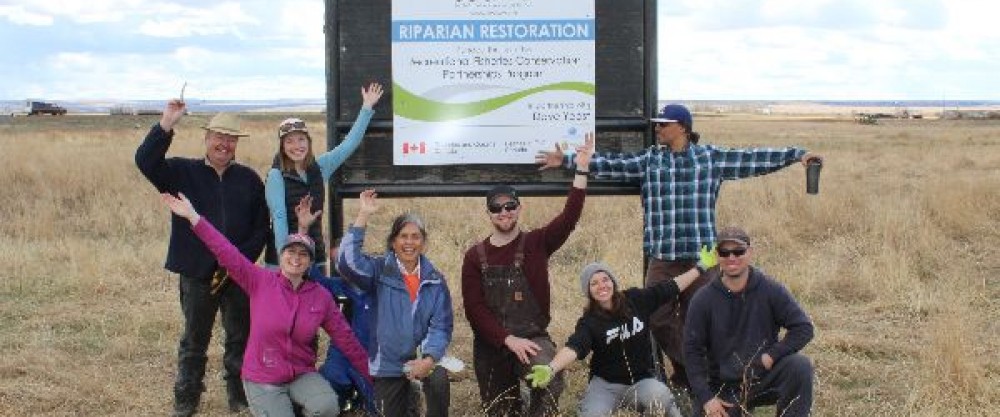
Riparian areas are lands adjacent to a body of water. They are transition zones between the water and the upland. When in healthy condition, they are often noticeable as narrow strips of lush and green vegetated natural areas along streams (rivers and creeks) or around lakes. Riparian areas may range from narrow valleys to wide floodplains. In a semi-arid climate such as the SEAWA watershed, these naturally green areas contrast vividly in appearance with the drier upland. The soil moisture gradient, from the wet water’s edge to the upland, creates zones of differing riparian vegetation.
On the shoreline where the water is not too deep, wetland plants are found. This portion of the riparian area is also known as a shoreline wetland. Farther away from the shoreline wetland is a zone of grasses and grass-like plants (sedges and rushes) and forbs (herbaceous plants – not grass or woody plants). Still farther away is a zone of shrubs, and finally there is a zone of trees bordering the upland. Some riparian areas may not have all of these vegetation zones.

The physical forces of moving water (stream flow or wave action) and the water depth also determine what plants can grow on the shoreline. For example, cattails (Typha latifolia) and hardstem bulrushes (Schoenoplectus acutus) are both wetland plants, but hardstem bulrushes are more tolerant of wave action and streamflow and can grow in deeper water. That’s why along a lakeshore, bulrushes are often the only vegetation with their shoots above water, farthest from the shore.
Learn more about riparian plants below:
Riparian Areas and Riparian Plants in the Seven Persons Creek Watershed (18.80 MB)Riparian Functions

Healthy riparian areas are essential components of a healthy aquatic ecosystem, or water body.
A river, creek, or lake is ecologically incomplete without a healthy riparian area. Riparian areas benefit people, wildlife, and the overall environment. They reduce the adverse effects of floods and drought and help regulate streamflow. They help improve water quality by trapping sediments and processing nutrients and other potential contaminants. They provide habitat and food for fish and wildlife, and the woody vegetation found growing in riparian areas stores carbon, helping in the global effort of reducing carbon dioxide emissions to combat climate change.
In agricultural areas, such as those found in the SEAWA watershed, riparian areas provide important habitat for pollinators such as bees. Additionally, riparian areas provide people with the opportunity to enjoy nature’s beauty.
To learn more about the functions of Riparian areas, see the document below:
Recognizing Riparian Ecological Services (1.03 MB)Our Call to Action: Conservation of healthy riparian areas. Restoration of degraded riparian areas. Control of invasive trees and weeds.
The condition of riparian areas can be assessed to provide ratings such as: Healthy, Healthy with Problems (problems are usually about the presence of invasive weeds), and Unhealthy (or degraded). A Riparian Health Assessment method is available at Health Assessment and Inventory Forms - Cows and Fish
Riparian Health Assessment of the Seven Persons Creek and its tributaries and lakes is available here: Riparian Health Assessment of the Seven Persons Creek
Riparian Health Assessments of the South Saskatchewan River at Medicine Hat is available here: Riparian Health Assessment 2015 - 2016 - South Saskatchewan River at Medicine Hat, Alberta.
Riparian Restoration
According to the Society of
Ecological Restoration (SER), ecological restoration is
the process of assisting the recovery of an ecosystem that has been degraded,
damaged, or destroyed. For sensitive ecosystems, such as riparian areas, restoration is crucially important as they are unlikely to return to a healthy state through natural succession alone.
Woody vegetation such as shrubs and trees are key green structural elements that generate riparian functions. SEAWA has been working on riparian restoration projects in the watershed since 2018, in an attempt to re-establish native plant communities by planting native shrubs and trees, and controlling invasive weeds.
These restoration efforts are in alignment with the South Saskatchewan Regional Plan (SSRP), as well as the government of Alberta's Water for Life strategy.
The UN Decade on Ecosystem Restoration 2021-2030 is a global effort aimed at restoring the planet and ensuring One Health for people and nature. Restoration of ecosystems provides resiliency to the effects of climate change on people and the overall environment. SEAWA’s riparian restoration projects in partnership with landowners, St. Mary River Irrigation District, and the city of Medicine Hat are in alignment with this global effort. THINK GLOBALLY; ACT LOCALLY
Restoration Project Team:
Project Lead & Restoration Ecologist - Marilou Montemayor
Project Team Members:
- 2022 - Ben White, Andrea Perez, Matthew Hoffart
- 2021 - Ben White, Alexi Nelson, Ian Mahon, Larry Paik, Sydney Taplin
- 2020 - Ben White, Alexi Nelson, Hannah Sabatier, Chris Beck, Larry Paik
- 2019 - Brooklyn Neubeker, Amy Adams, Ben White, Brandon Jarvis, Sheldon Gill
- 2018 - Natasha Rogers, Seline Solis, Patrick Jablowski
Some of the native species planted by SEAWA are:
And more!
Restoration Sites
SEAWA currently has restoration projects at four sites, each with its own host of challenges, and techniques for making restoration successful. These sites are:
- Yeast (Seven Persons, AB) - In partnership with David Yeast
- Sauder Reservoir (County of Forty Mile, AB) - In partnership with the Saint Mary River Irrigation District (SMRID)
- Connaught Pond (Medicine Hat, AB) - In partnership with the City of Medicine Hat
- Saratoga Park (Medicine Hat, AB) - In partnership with the City of Medicine Hat
Riparian restoration involves partnership with landowners or land managers. SEAWA has been fortunate in securing partnerships and implementing riparian restoration projects at various sites in the SEAWA watershed. This video shows some of what SEAWA has done with the co-operation of local landowners.
Riparian restoration project updates are regularly provided in SEAWA newsletters, and Annual Reports.
Restoration Techniques
In its restoration efforts, SEAWA has implemented two approaches. The first is passive restoration – isolating the cause or causes, for example, through installation of barriers (fences). The second is active restoration – replacing lost and damaged elements, maintaining them, and preventing further damage or degradation.
Passive restoration:
Fencing off livestock
Fencing off pets & people
Livestock off-stream watering systems
Active restoration:
Revegetation with native species
Student Practicum
In recent years, SEAWA has had opportunities to work with post-secondary students seeking work experience credit in their environment related programs. This kind of relationship is mutually beneficial, and SEAWA is glad to participate in such arrangements. To date, SEAWA has worked with:
- Amy Adams, University of Calgary: Bachelor's Degree Co-op Program (2019)
- Ben White, Medicine Hat College: Reclamation Technician Practicum (2019)
- Keely Gilham, Royal Roads University: Master's Degree Field Work (2020)




